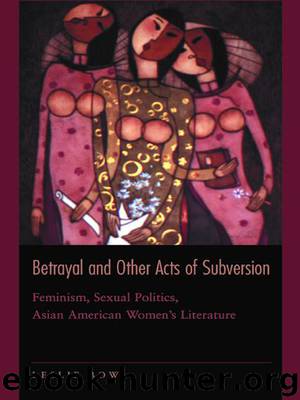Betrayal and Other Acts of Subversion by Leslie Bow

Author:Leslie Bow
Language: eng
Format: epub
Publisher: Princeton University Press
Four
* * *
Third World Testimony in the Era of Globalization
LE LY HAYSLIP'S BAD (GIRL) KARMA AND THE ART
OF NEUTRALITY1
“Boo-sheeit! I ain't never gettin' hit in Vietnam.”
“Oh no? Okay, mothafucker, why not?”
“'Cause,” Mayhew said, “it don't exist.”
(Michael Herr, Dispatches)
Tell all the Truth but tell it slant—
(Emily Dickinson)
“[L]OOK INTO THE HEART of one you once called enemy,” writes Vietnamese immigrant Le Ly Hayslip. “I have witnessed, firsthand, all that you went through. I will try to tell you who your enemy was” (xiv). Hay-slip's 1989 autobiography, When Heaven and Earth Changed Places: A Vietnamese Woman's Journey from War to Peace, thus promises a glimpse into what remained opaque and incomprehensible to both a television viewing audience and the soldier in the field—the heart of “our enemy.” The autobiography marks yet another first-person contribution to the discourse of a war that has been said to defy representation. The incommunicability of the Vietnam experience has been a primary theme within veterans' discourse, ironically in spite of the fact that it is dominated by experiential accounts that link notions of authenticity and authority to “being there.” Michael Herr's portrayal of a soldier's belief in his invincibility reflects two conventional perspectives on the war; first, that Americans were only fighting themselves, and second, that the trauma of the experience renders it essentially untransferable, hence unreal. Le Ly Hayslip's autobiography stands out among these firsthand accounts if only because it seems to offer an alternative view—that of a Vietnamese peasant woman. And to some extent it does succeed in countering dominant American representations of the Vietnamese people as mere backdrops to a hellish landscape. Vietnam and the Vietnamese, her story testifies, exist.
Hayslip's story is a commodity in the glutted American media market on the war only to the extent that her race, gender, national, and class alterity would indicate that her account does not simply replay that of the journalist or solider in the field or the “multicultural” narratives of female nurses or African American GIs. But does it serve an alternative purpose either in the domestic sphere or in the context of global restructuring? The text does diverge from many of these accounts in the overt-ness of its intention. Hayslip's testimony performs a more specific function than reminding a forgetful American public that its so-called dirty war has continued to impact a nation. In its invocation of a firsthand experience of the war and its structure as a narrative of conversion, Hay-slip's work reflects the activist potential of autobiography, where the life of the individual is intended as an allegorical commentary. The book's purpose is fairly straightforward—its goal is to “heal old wounds” by elucidating the effects of war and to call for the rebuilding of Vietnam through activism and humanitarian aid. The end of the text directs the reader to various agencies committed to this task, including Hayslip's own, the East Meets West Foundation. The 1993 sequel, Child of War, Woman of Peace, “America's story, written with a bamboo pen” (4), details not only the
Download
This site does not store any files on its server. We only index and link to content provided by other sites. Please contact the content providers to delete copyright contents if any and email us, we'll remove relevant links or contents immediately.
4 3 2 1: A Novel by Paul Auster(11817)
The handmaid's tale by Margaret Atwood(7468)
Giovanni's Room by James Baldwin(6823)
Asking the Right Questions: A Guide to Critical Thinking by M. Neil Browne & Stuart M. Keeley(5364)
Big Magic: Creative Living Beyond Fear by Elizabeth Gilbert(5361)
Ego Is the Enemy by Ryan Holiday(4967)
On Writing A Memoir of the Craft by Stephen King(4673)
The Body: A Guide for Occupants by Bill Bryson(4595)
Ken Follett - World without end by Ken Follett(4452)
Bluets by Maggie Nelson(4279)
Adulting by Kelly Williams Brown(4243)
Eat That Frog! by Brian Tracy(4167)
Guilty Pleasures by Laurell K Hamilton(4126)
White Noise - A Novel by Don DeLillo(3837)
The Poetry of Pablo Neruda by Pablo Neruda(3825)
Fingerprints of the Gods by Graham Hancock(3746)
Alive: The Story of the Andes Survivors by Piers Paul Read(3743)
The Book of Joy by Dalai Lama(3710)
The Bookshop by Penelope Fitzgerald(3625)
